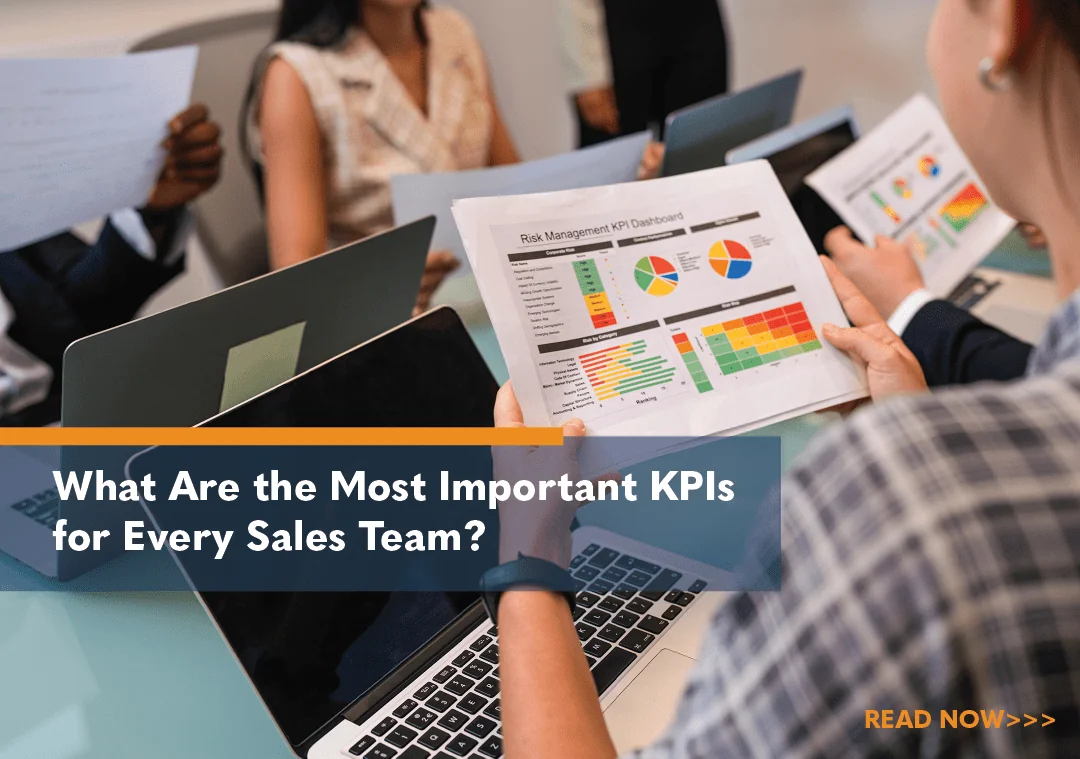What Are the Most Important KPIs for Every Sales Team?

In sales, we can accumulate a lot of data. Sometimes, it can feel like managing a CRM requires a Ph.D. in Data Science. As new technologies are added to the sales tech stack, the number of reports increases. This means more data, which can make deciding which metrics to track overwhelming. If you’ve ever felt more like a data scientist than a sales leader, we get it.
However, no matter how we feel about data, our reliance on it is expected to grow. In fact, an article in ScienceDirect notes 84% of leading firms have started big-data initiatives. These are expected to reduce expenses and create opportunities. Specifically, they note innovation in supply chain and customer relationship management.
Moreover, for sales organizations, data is essential in coaching. Beyond numbers in a CRM, data identifies coaching opportunities. These can turn a sales rep’s weaknesses into strengths. Here, we’ll explore key sales metrics, including both leading and lagging indicators, and discuss the top five essential KPIs. We’ll also examine leveraging data to enhance coaching strategies.
Understanding Leading and Lagging Indicators
Before discussing specific KPIs, we must first understand where these metrics come from. Generally, in sales, data is distributed between two buckets, leading and lagging indicators.
Leading indicators are sometimes called “forward metrics” because they look forward. In contrast, lagging indicators look back on past performance. To be effective, organizations cannot only focus on sales performance outcomes. They must also understand how those outcomes were achieved.
Leading indicators measure processes in the sales cycle that predict outcomes. These include the ratio of leads to sales calls and the ratio of calls to quotes. It also includes opportunity forecasting and the percent certainty of closure (EV or Expected Value). In other words, beyond goals themselves, leading indicators examine the steps in achieving the goals,
Lagging indicators measure the outcome of sales efforts. This includes top line revenue, margin, the cost per sale, revenue per rep, etc. At Janek, we see many sales teams that only focus on lagging indicators. Why? Because reps and sales managers get paid based on these metrics. However, they only reveal part of the picture.
What Are Leading Indicators?
Activity KPIs are useful to compare a sales rep’s performance against team benchmarks and historical data. These reveal how active or engaged a rep is, providing insights into their drive and motivation. They are typically logged into your CRM through email plugins, phone dialer software, or LinkedIn Sales Navigator.
Examples of Leading KPIs:
- Number of calls made
- Number of emails sent
- Lead-to-Opportunity conversion
Generally, underwhelming leading indicators have two causes: the sales rep either lacks skills or knowledge or they lack motivation. Poor data management and not tracking activities can also contribute to the issue.
Skill deficiencies can often be addressed through targeted coaching. However, motivation issues can be more complex. Once the root cause is identified, managers can provide focused coaching. This can include refining phone/email strategies, enhancing presentation techniques, or the better use of tech.
What are Lagging Indicators?
Lagging KPIs are essential outcome metrics that evaluate overall performance. These indicators, which include total sales and revenue, are influenced by leading KPIs. However, as noted, they do not provide a complete picture. Therefore, they should not be the sole basis for performance assessments.
Examples of Lagging KPIs include:
- Number of deals won and lost
- Amount of won deals
- Average size of deals won
- Average length of the sales cycle
A decline in performance can result from any number of factors. For example, a rep who excels at building relationships but struggles with advancing opportunities to close. Maybe they are less assertive or have a longer sales cycle compared to their peers. By examining leading KPIs, managers can pinpoint specific issues and trends that contribute.
Despite their limitations, lagging KPIs are still crucial. They should be reviewed with the sales rep and compared against benchmarks, peer performance, and quarterly/annual goals.
For more, see our blog The Everyday Guide to Leading and Lagging Indicators.
The Top Five KPIs Every Sales Leader Must Know
Now that we’ve addressed where our metrics come from, let’s examine the top five KPIs leaders must know. These provide a roadmap for uncovering new opportunities and optimizing performance and include:
1. Total Revenue
Revenue is the total amount of money an organization makes through selling their products and services. Measured over a specific timeframe, it is a crucial indicator of whether sales goals are being met. It informs decisions about budgets, investments, and the structure of sales teams. Revenue can be further analyzed by:
- Sales reps
- Territory
- Products
- New vs. existing accounts
2. Sales Velocity
This is also called deal velocity or pipeline velocity. It is how quickly your sales team generates revenue. This is essential for forecasting, evaluating sales processes, setting targets, and equipping sales teams. The formula for sales velocity is:
- Sales Velocity (SV) = Number of leads x average deal size x conversion rate divided by the average length of the sales cycle.
For instance, with 10 leads, an average deal size of $15,000, a 25% conversion rate, and a 90-day sales cycle:
- (10 15000 x .25) / 90 = 416.66
Sales velocity can also be broken down into:
- Cross-sell rates
- Upsell rates
- Existing accounts
3. Conversion Rates
Conversion rates represent the percentage of potential leads or prospects who successfully complete a desired action, such as signing a contract, purchasing a product, or moving to the next stage in the sales funnel, out of the total number of leads initially engaged.
Benchmarking conversion rates can vary by industry and types of products/services. Typical conversion rates include:
- Lead conversion rate
- Opportunity conversion rate
- Cross-sell and upsell rate
4. Average Deal Size
This measures the amount of money a client spends on your products and services in a specific timeframe. It is calculated by dividing the total revenue generated by the number of closed-won deals.
This provides insights into your sales team’s effectiveness. Important factors include:
- Ability to sell value
- Understanding customer needs
- Identifying cross-sell and upsell opportunities
Quite simply, the larger the deal, the more money you stand to make. It can also reveal opportunities within accounts. Increasing deal size can boost revenue and help sales reps meet or exceed their quotas.
5. Cost of Sales (or Selling Expenses)
The total cost of selling your products and services. This includes:
- Resources
- Labor
- Storage
- Delivery
- Marketing
- Go-to-market
It is essential for assessing the profitability of individual deals. As this impacts commission structures and percentages, it is crucial for financial planning and performance evaluation.
Of course, most of these are outcome-based or lagging indicators. However, it’s easy to see how many relate back to activity or leading metrics. For example, the number of calls/ emails, number of conversations, appointments, etc. Thus, these metrics can see the greatest lift through sales coaching.
Leveraging Data in Sales Coaching
Sales coaching is the art and science of empowering sales professionals to reach their highest potential. It is the nexus between people and data. Today, it must incorporate personalized feedback, skill development, and strategic planning. The goal is to motivate, increase performance, and drive results. Effective coaching techniques include:
- Team meetings
- One on ones
- Role play
- Recoded calls
- Real-time coaching
Through this, sales managers build trust and manage the well-being, motivation, and accountability of the people who sell.
Of course, data analysis plays a pivotal role. By scrutinizing key metrics, coaches identify patterns. Through these, they can pinpoint strengths and weaknesses. Most importantly, they can then tailor coaching strategies to meet the specific needs of their team members.
An essential component of sales coaching is analyzing leading and lagging KPIs on a granular level. This includes between sales coaching sessions. “Progress KPIs” can track incremental changes rather than quarterly or yearly performance outcomes. This is especially useful to monitor reps who show steady progress due to experience or coaching. These include:
- Sales calls/emails
- Leads generated
- Meetings booked
- Conversion rates
Managers can evaluate improvement between coaching or review progress monthly. This data can boost confidence. Further, this detailed analysis helps identify specific areas that require additional attention. For example, reps who struggle generating leads or moving them through the funnel.
As important, data analysis can reveal reps who are not yet top performers but are making significant strides. These are ones who require the most attention. They may also provide the greatest returns.

Contact Janek Performance Group to Help You Better Understand Your KPIs
While some sales managers thrive on analyzing data, others are less enthusiastic. Number-crunching just isn’t their thing. Often, these managers prefer the human side of leadership, building up and inspiring their sales teams.
However, regardless of preference, the importance of data is not going away. In fact, it’s only increasing. Like it or not, successful sales leaders use data to enhance coaching. Leveraging these insights can transform mere statistics into actionable strategies that motivate sales teams and boost performance. We hope this helps managers more effectively leverage sales data in their coaching.
For more on being an effective sales manager, see our white paper How to be a High-Performing Sales Leader in Today’s Marketplace.
Updated 08/26/2024
- Understanding Leading and Lagging Indicators
- What Are Leading Indicators?
- What are Lagging Indicators?
- The Top Five KPIs Every Sales Leader Must Know
- 1. Total Revenue
- 2. Sales Velocity
- 3. Conversion Rates
- 4. Average Deal Size
- 5. Cost of Sales (or Selling Expenses)
- Leveraging Data in Sales Coaching
- Contact Janek Performance Group to Help You Better Understand Your KPIs

- Account Planning (11)
- Awards (50)
- Client Testimonial (37)
- Personal Branding (19)
- Podcast (11)
- Research (69)
- Sales Career Development (85)
- Sales Coaching (154)
- Sales Consulting (133)
- Sales Culture (164)
- Sales Enablement (345)
- Sales Leadership (110)
- Sales Management (242)
- Sales Negotiation (16)
- Sales Prospecting (120)
- Sales Role-Playing (18)
- Sales Training (231)
- Selling Strategies (256)
- Soft Skills (67)
- Talent Management (92)
- Trusted Advisor (27)
- Virtual Selling (41)
- Webinar (11)




























